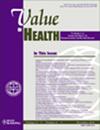A Systematic Review and Meta-Analysis of Health-State Utility Values for Infectious Diseases With Pandemic Potential and Associated Vaccine Adverse Reactions
IF 6
2区 医学
Q1 ECONOMICS
引用次数: 0
Abstract
Objectives
The COVID-19 pandemic and its vaccine deployment have illustrated the importance of estimating the disease burden of the pandemic and vaccine adverse reactions in a comparable fashion. The objective was to evaluate health-state utility value (HSUV) scores for infectious diseases with pandemic potential and associated vaccine adverse reactions.
Methods
We included studies from which we could extract a single HSUV associated with priority infectious diseases with pandemic potential or associated vaccine adverse reactions. We assessed risk of bias using the criteria recommended by National Institute for Health and Care Excellence. We conducted random-effects meta-analyses.
Results
We included 39 studies, and data synthesis was conducted for COVID-19, influenza, and dengue for infectious diseases and myocarditis and narcolepsy for vaccine adverse reactions. Response rates varied (2%-98%), whereas follow-up rates ranged from 68% to 100%. Twenty-four studies did not report how they handled missing data. Compared with control groups, COVID-19 (acute phase) and influenza (acute phase) had reduced EQ-5D scores: −0.11 (95% CI −0.14, −0.07) in COVID-19 and −0.50 (95% CI −0.60, −0.41) in influenza. For associated vaccine adverse reactions, the mean EQ-5D score for myocarditis and PedsQL score for narcolepsy were 0.88 (95% CI 0.76, 1.00) and 64.0 (95% CI 59.4, 68.7), respectively. No apparent asymmetry was observed in funnel plots.
Conclusions
This study provided HSUV scores for some infectious diseases with pandemic potential and associated vaccine adverse reactions. These results can be used as HSUV indicators for future health technology and cost-effectiveness assessments.
对具有大流行潜力的传染病和相关疫苗不良反应的健康状态效用值的系统回顾和荟萃分析。
背景:COVID-19大流行及其疫苗部署说明了以可比方式估计大流行疾病负担和疫苗不良反应的重要性。目的是评估具有大流行潜力的传染病和相关疫苗不良反应的健康状态效用值(HSUV)评分。方法:我们纳入了可以从中提取与具有大流行潜力的重点传染病或相关疫苗不良反应相关的单一HSUV的研究。我们使用国家健康与护理卓越研究所(NICE)推荐的标准评估偏倚风险。我们进行了随机效应荟萃分析。结果:我们纳入了38项研究,并对COVID-19、流感和登革热的传染病以及心肌炎和发作性睡症的疫苗不良反应进行了数据综合。应答率各不相同(2-98%),随访率为68-100%。24项研究没有报告他们如何处理丢失的数据。与对照组相比,COVID-19(急性期)和流感(急性期)的EuroQoL 5维度(EQ-5D)评分降低:COVID-19组为-0.11(95%可信区间为-0.14,-0.07),流感组为-0.50(95%可信区间为-0.60,-0.41)。对于相关疫苗不良反应,心肌炎的EQ-5D评分平均值为0.88 [95% CI 0.76, 1.00],发作性睡症的PedsQL评分平均值为64.0 [95% CI 59.4, 68.7]]。漏斗图未见明显的不对称性。结论:本研究为一些具有大流行潜力的传染病及相关疫苗不良反应提供了HSUV评分。这些结果可作为未来卫生技术和成本效益评估的HSUV指标。
本文章由计算机程序翻译,如有差异,请以英文原文为准。
求助全文
约1分钟内获得全文
求助全文
来源期刊

Value in Health
医学-卫生保健
CiteScore
6.90
自引率
6.70%
发文量
3064
审稿时长
3-8 weeks
期刊介绍:
Value in Health contains original research articles for pharmacoeconomics, health economics, and outcomes research (clinical, economic, and patient-reported outcomes/preference-based research), as well as conceptual and health policy articles that provide valuable information for health care decision-makers as well as the research community. As the official journal of ISPOR, Value in Health provides a forum for researchers, as well as health care decision-makers to translate outcomes research into health care decisions.
 求助内容:
求助内容: 应助结果提醒方式:
应助结果提醒方式:


